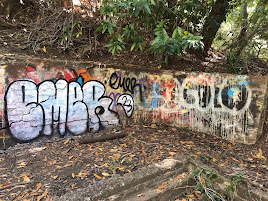//10 sites of nostalgia and decay//
I've been collecting spaces for years, so some of these photos are somewhat old and some are very new. While they might all look very different, there are common themes binding them together - my interests in science fiction and urban decay, in imaginary futures, in the old and cherished, in the breaking down of things and the potential for making things anew out of wreckage.
space 1: submarine interior
This is the interior of the USS Blueback, a retired submarine that now lives at the Oregon Museum of Science and Industry in Portland, OR., which I got to visit last June. Despite having been launched in 1959, this imagery feels futuristic to me, albeit in a nostalgic, retro, original Star Trek way. It comes with connotations of the idealized future Star Trek offers, in which humans and aliens work together in peace and harmony to travel the stars and gather knowledge, in which money no longer exists and everyone has access to what they need to thrive.
space 2: graffiti at park
This park is a few blocks from my home in San Carlos, CA. If one climbs up into the hills away from the children's play areas and main trails, one can find this undisclosed concrete structure covered in graffiti. I love the mystery of this old concrete place interrupting the nature all around it (and slowly being reclaimed by that nature) - invasive grasses and bay laurel trees and lots of poison oak, and this odd relic, that people have chosen to use as a surface for art.
space 3: old car on remote hillside
space 4: doorways within doorways
space 5: stage through chain link
space 6: cemetery
space 7: resistance to remaking I
space 8: resistance to remaking II
The tunnel behind the College Avenue shops. There used to be graffiti in this tunnel, which has since been painted over. This is another way of interacting with a space, a continued interruption, a thwarting of someone else's vision and work. I'm interested in this resistance to remaking, and I also just like the weird white tetris-y shapes against the gray concrete wall.
I've never lived in a house with a basement before, so it's still strange and wonderful to me that this place exists (Sol House, across the street from Big Exec). In contrast to the previous two spaces, this space is actively and joyfully being remade by the people who live in my house; odds and ends, like the mannequin and wall vinyl, have slowly accumulated, and the pipes criss crossing the ceiling are adorned with string lights. There's something conceptually fascinating to me about basements - something about the secret life of the liminal space above which life happens.
Another basement shot. This is one of the deep recesses of the basement; I'm pretty sure it's not even under the house at this point, but then again, it's weird and liminal, so maybe my sense of space is way off. I love the faded green door, the humming electrical box, all the junk that's been stuck down here over the years. Nostalgia plays heavily into my love for this corner of the basement. I wonder how long this corner has looked roughly like this, and how long it will continue to look roughly like this after I've moved out.


















I love all your spaces; they look so cool. I also like how you described space 7. Also, the old car in a place where it seems out of place is intriguing, resembling the traces of a 'failed expedition'.
ReplyDelete